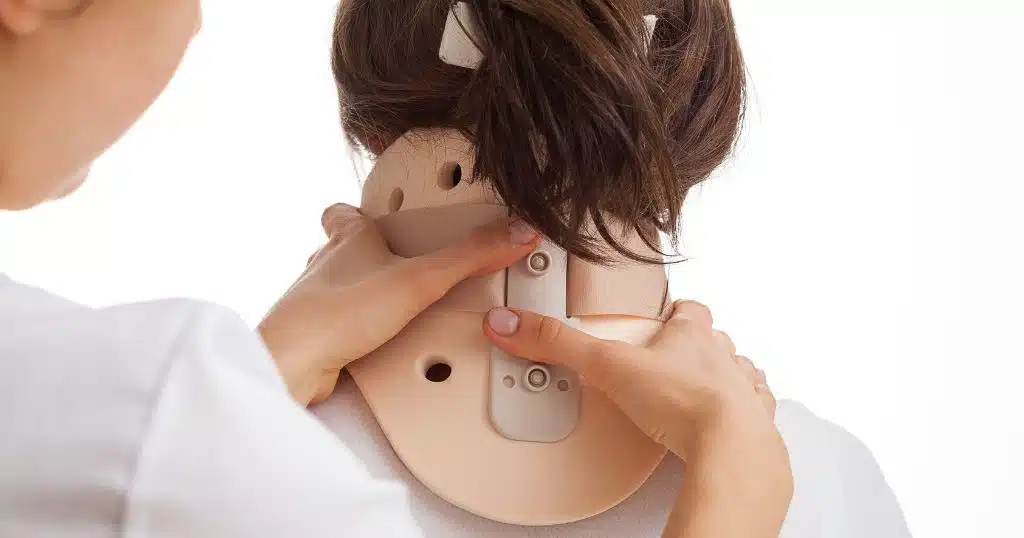
We’re passionate about providing healthcare professionals and patients with the knowledge they need. This topic is helpful for anyone who is seeking comfort, support, and healing for their neck. Cervical collars, also known as neck braces or neck immobilisers, aren’t just accessories; they’re lifelines for those who suffer from neck injuries or post-surgical recovery. Think of them like a sturdy yet gentle embrace around the neck, providing stability, relief, and a pathway to healing.
Let’s understand common use. Here are the scenarios where cervical collars step into the spotlight :
After Injury
Whether it’s a sudden accident, a fall, or a sports-related mishap, the neck often bears the brunt. Cervical collars L0174 become your allies, offering support and minimizing damage.
Post-Surgery
Picture a patient emerging from the operating room, their neck delicately stitched after a procedure. The collar becomes their silent guardian, ensuring the surgical site remains undisturbed.
Neck-Related Conditions:
From whiplash to cervical strain, our necks endure more than we realize. They provide relief, allowing strained muscles and ligaments to heal without unnecessary movement.
What is the main purpose of cervical collars?
Restriction of Motion
You’ve experienced a neck injury or undergone surgery. Your neck delicate and intricate—needs protection. That’s where cervical collars step in. Their primary mission? Limiting neck movement. By doing so, they prevent further damage to those vulnerable structures. No unnecessary bending, twisting, or rotation—just a gentle yet firm hold to keep things in check.
Immobilization: The Rigid Embrace
Our cervical collars aren’t mere accessories; they’re like loyal bodyguards for your neck. Crafted from sturdy materials—think plastic or foam—they create a rigid support system. Imagine slipping into a snug-fitting armor that says, “Fear not, dear neck, I’ve got your back!” Straps or Velcro closures ensure a secure fit, immobilizing any rogue movements that could disrupt the healing process.
Aligning the Spine for Healing
Healing is an art, and proper alignment is its canvas. Cervical collars play a crucial role in maintaining spinal harmony. They cradle the weight of your head, ensuring it stays neutral—aligned with the rest of your spine. Why is it important? Because when your neck structures heal, they need the right environment. Think of it as a symphony—the collars conduct the healing orchestra, ensuring every note is in tune.
Let's Understand Types of Cervical Collars
Soft Collars: Gentle Guardians
Soft collars, like caring companions, step in when minor injuries knock on our neck’s door. These are the comfort blankets of the cervical collar family. Here’s why they matter: Ideal for Minor Injuries: Think sprains, strains, or mild discomfort. Soft collars provide just the right amount of support without overwhelming the neck. Foam or Fabric: Picture a soft, cushiony embrace. That’s what these collars offer—gentle yet effective.
Rigid Collars: The Fortified Protectors
When the stakes are higher—severe injuries or post-surgery scenarios—the stage belongs to rigid collars. These are the knights in shining armour for your neck: Strength and Stability: Crafted from materials like plastic or firm foam, rigid collars mean business. They create a fortress of stability around your neck. Secure Fit: Straps or Velcro closures ensure these collars stay put. No wobbling allowed!
Philadelphia Collars and Aspen Collars: The Artisans
Now, let’s meet the artisans the specialized designs that cater to specific needs: Philadelphia Collars: Imagine a collar with a chin piece. That’s the Philadelphia collar! It’s like a tailored suit for your neck, providing extra stability and alignment. Aspen Collars: These collars come with adjustable settings. They’re like the Swiss Army knives of neck support—adaptable, versatile, and ready for any healing journey.
Fascinating, isn’t it? The world of cervical collars is more than meets the eye.
Do you know when doctors prescribe the collars?
Trauma Strikes
Life can be unpredictable. Accidents, falls, or intense sports moments—our necks bear the brunt. When trauma knocks on our door, cervical collars become our steadfast companions: After Accidents: Picture a car collision or a sudden fall. The neck, delicate and vulnerable, needs support. Cervical collars swoop in, restricting movement and preventing further harm.
Sports Injuries:
Whether it’s a soccer tackle or a gymnastic mishap, our necks deserve protection. Collars offer stability, allowing the injured structures to heal without unnecessary strain.
Post-Surgery Guardians
Imagine a patient emerging from the operating room, their neck freshly stitched after surgery. Here’s where cervical collars play their crucial role: Post-Operative Care: Surgery leaves its mark a delicate site that demands protection. Collars wrap around the neck, shielding the surgical area. They’re like sentinels, ensuring no accidental jostling disrupts the healing process.
When Neck Pain Takes Center Stage
Neck pain—those two words can alter our daily lives. Cervical collars step in to ease the burden:
Whiplash: That sudden jerk—ouch! Whiplash strains the neck. Collars provide relief, minimizing movement and allowing strained muscles to recover.
Cervical Strain: Whether it’s from poor posture or overexertion, neck strain calls for support. Collars stabilize, giving our necks a chance to heal.
Spinal Instability: A Delicate Balancing Act
Fractures or dislocations: Our spine faces challenges. Cervical collars become our allies: Fractures: When bones break, stability becomes paramount. Collars maintain alignment, preventing further damage. Dislocations: Picture a misaligned vertebra. Collars hold the fort, allowing the spine to find its equilibrium.
Proper Application and Fitting of Collars
Let’s ensure that these neck guardians fit like a tailored suit—comfortable, snug, and effective.
Measure Twice, Secure Once
Before we fasten those straps, let’s measure. The neck circumference holds the key. Imagine wrapping a soft tape around the neck just like a gentle hug. Not too tight, not too loose. We’re aiming for Goldilocks perfection here.
Positioning: Snug, Not Suffocating
Picture this: You’re securing a collar on a patient. The goal? A snug fit that says, “I’ve got you covered.” Here’s how: Snugness: Tight enough to stay put, but not so tight that it feels like a boa constrictor’s embrace. Comfort: No digging into the skin, no red marks. Just cozy support.
The Chin and Jaw Tango
Ah, the delicate dance of alignment! Imagine your chin and jaw as dance partners. They need to waltz in harmony: Chin Piece (for Some Collars): If your collar has a chin piece (like the Philadelphia collar), ensure it cradles the chin gently. No chin-chafing drama, please! Jaw Alignment: The collar should align with the jawline. Think of it as a symphony—the jaw, collar, and neck in perfect harmony.
Potential Complications Patients Face from These Collars
Muscle Atrophy: The Silent Saboteur
Picture this:
Your neck, encased in a protective collar, rests—almost too comfortably. But here’s the catch: muscles need movement. Prolonged immobilization can lead to muscle atrophy—the gradual weakening of those neck warriors. It’s like a gym membership you didn’t sign up for. Fear not, though! As healing progresses, gentle exercises will coax those muscles back into action.
Skin Irritation:
The Pressure Points Tango Collars, while steadfast, can sometimes be a tad clingy. Imagine wearing a snug turtleneck for days on end. Pressure points emerge the spots where collar and skin meet. These points can turn grumpy, causing redness, discomfort, and even allergic reactions. Our advice? Regular checks, a dash of padding, and perhaps a soothing lotion for your neck’s sake.
The Psychological Tug-of-War
Ah, the mind—a powerful player in the healing game. Extended collar wear can take a toll: Discomfort: Imagine feeling like you’re in a neck hug 24/7. It’s cozy at first, but then—well, it’s like that overly affectionate relative who overstays their welcome. Restricted Movement: The world beckons, but your collar says, “Not so fast!” It’s a dance of frustration and patience.
Gradual Weaning and Rehabilitation: Weaning Off Collars
Healing, Step by Step
Your neck, cocooned in a collar, has journeyed through pain, protection, and stability. But now, as healing whispers its promises, it’s time to loosen the grip. Here’s why gradual weaning matters: Healing Progress: As your body heals, it craves freedom. Collars, like diligent sentinels, have done their duty. Now, they step back, allowing your neck to regain its natural movement. Baby Steps: Gradual weaning ensures a smooth transition. Think of it as teaching a fledgling bird to fly—little hops, then longer glides.
The Dance of Rehabilitation Exercises
Ah, the magic lies in movement! As the collar loosens its embrace, rehabilitation exercises take center stage:
Physical Therapy:
Ah, the magic lies in movement! As the collar loosens its embrace, rehabilitation exercises take center stage:
Cervical collars—these unassuming devices—have played a pivotal role in your healing journey. They’ve cradled your neck, whispered promises of stability, and stood guard while your body worked its magic. Remember, they’re not just accessories; they’re lifelines. From trauma to surgery, neck pain to spinal instability, collars have been there. They’ve restricted motion, created a fortress of support, and aligned your spine. Each snug fit was a step toward healing—a gentle nudge in the right direction. As healthcare providers, we’re passionate about your well-being. But here’s the truth: personalised advice matters. Consult your healthcare professionals.
As a trusted L0174 Cervical Collars supplier, Ava Medical Supply proudly offers the L0174 Cervical Collar—a beacon of support and healing for neck-related challenges. Whether you’re a healthcare professional seeking quality products or a patient on the path to recovery, we’ve got you covered.
Explore our range of L0174 Cervical Collars today and experience the difference. Remember, your patient’s neck deserves the best because healing begins with the right support.
Stay well, stay informed, and keep those collars snug!













